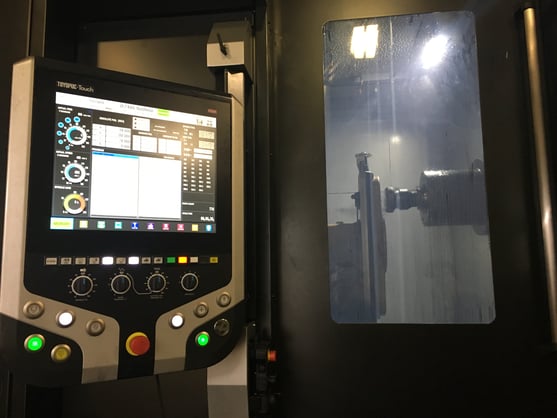In production manufacturing, efficiency is king. Any opportunity to reduce production time gets immediate attention.
CNC machines are an important tool for automating the production of mechanical parts to increase throughput while maintaining consistent quality. CNC machine centers play a critical role in a machine shop’s efficiency.
This article explains five big advantages of CNC machine centers and shares some experienced insights from a leader in CNC machining.
1. Performance
Speed. Much of what drives efficiency is speed. High speeds reduce CNC machine cycle time tasks. One example is moving the spindle home for changing tools and then positioning the cutting tool precisely where it needs to be prior to cutting.
How fast are CNC machines? The maximum feed and rapid rates can exceed 2,300 inches per minute (ipm), which is faster than three feet per second.
Depending on several factors (part material, tool, path, depth of cut), cutting feeds can exceed 300 ipm, a ballpark for face-milling aluminum. Plus, all functions are done — including the machine repeatedly locating all features — within a fraction of a millimeter.
Precision. When a workpiece needs to hit tight tolerance goals, precision machining is often the answer. CNC machines, due to their design and construction, can cut as precisely as 0.001”. That is literally splitting hairs. Plus, as mentioned, it’s accomplished at incredible speeds.
Repeatability. Running from a computer program that controls the machining process with consistency and precision, a CNC machine reliably repeats all steps. As far as day-to-day operations, repeatability issues more often involve the rigidity of the part and work holding or the tooling wearing down, not typically the machine’s performance.
2. Flexibility
Programmable. The basic operation of CNC machining is clearcut: the machine is programmed to process the part using different tools. Engineers often use a visual 3D computer-aided design and manufacturing (CAD/CAM) software tool that outputs G-code, which runs on the CNC machine. Programs are downloaded to, and sent back from, a CNC machine remotely by engineers or the production team.
Adaptable by Setup. Setup is the process of switching over a CNC machine to run a new part. Fixtures, which hold parts in the machine for processing, are designed for each part, and they are interchangeable. Also interchangeable, cutting tools are selected to optimally produce each part. So, at the start of a new job, tools, fixtures, and programs are changed over, making CNC machines flexible to produce different parts. Additional flexibility is realized by having multiple machines of the same type, with any of them having the ability to run a given part.
Types and Sizes. CNC machines come in different types — a lathe spins the part with a fixed cutter (great for cylindrical parts) while a mill rotates a tool for cutting. While CNC machines and pallets (where the fixture sits) are small or large, they’re very similar when it comes to programming and operations. There typically is a best-fit machine for parts ranging from small to large.
3. Automation
Automatic Changers. A CNC machine changes tools using an automatic tool changer (ATC). With the program controlling tooling and processes, the machine starts the cutting features with a face mill and, when finished with this tool, automatically changes to another tool, similar to a handheld drill.
Many CNC machines include two pallets that are exchanged with an automatic pallet changer (APC). One pallet is accessible by the operator (for loading, unloading, processing, etc.) while the other is in the cutting area. This improves spindle utilization, as the machine cuts while the operator processes, unloads, and loads parts.
Hydraulic Fixtures. Hydraulics systems are often incorporated to clamp, unclamp, and support the part. Parts are clamped — in the exact same sequence at the same pressure — with the push of a button. These fixtures improve repeatability, consistency, and loading efficiency … all very much needed in production machining.
Uptime Features. Material waste (usually in the forms of chips and shavings) are removed automatically by a conveyor, and the coolant is separated for reuse. The CNC machine also tracks tool wear and use, with the tool monitor alerting a CNC operator when a tool should be replaced. Uptime is increased by staying in front of issues and running to the expected tool life.
Standardizing Setups. The CNC setup process can be formalized to yield consistent manual changeovers. A setup checklist defines every step, covering fixtures, programs, tools, and first article. While not “automated,” formalizing the manual process ensures consistency.
4. Adaptability
Tool Capacity. Standard tool capacity is typically around 20 to 60 tools, depending on the CNC machine type, but this can be 100, 200, or more if the part is complex. A large tool matrix (240+ tools) is also used when running multiple parts with varying features, which eliminates the need to switch tools.
Pallet Automation. A pallet pool system moves pallets in and out of a CNC machine, allowing for multiple parts/pallets to be run while eliminating the manual setup repetition. Each part can be set up manually once and then autonomously changed over.
Different Spindles. There are high-torque spindles that are beneficial for cutting iron and hard materials and high-speed spindles that provide maximum material removal rates and best surface finishes. Matching the spindle to the need is critical to maximizing efficiency.
Tool Breakage Sensors. To maintain quality control and prevent unnoticed production defects, sensors touch the tool to measure and check length. Too short? The tool is likely broken. Because of their ability to detect tool failures, these sensors may be standard in horizontal CNC machine centers.
High-Pressure Coolant. Used in machines to run certain tools, high-pressure coolant helps create consistent cutting by removing chips, or waste, from a part.
Gantries and Robots. To further automate processing of parts, additional equipment can be added to a CNC machine. Gantries and robots can be interfaced to lift, load, unload, and further process parts, including moving parts from CNC fixtures to and from dunnages or conveyors.
Probing. Used in setup and also during part production to check the part, probes also help the cutting program be offset against the probe measurement. For example, if machining tolerances are hard to control from a work holding alone, a casting feature can be found precisely by probing.
5. Supply Base
Legacy and Evolution. CNC machines are known for their reliability, running two decades or more without major issues. Current technology is pushing innovation, with suppliers regularly introducing new machine features, and adding more machine monitoring and remote diagnostics.
Market Competition. Within a highly competitive market, CNC machine manufacturers push each other to keep improving and adding features while holding costs down.
Manufacturing Partnerships. CNC machine shops usually develop strong partnerships with suppliers, who get to know shops’ core needs and business models. When automation or machine customization demands arise, suppliers are often ready to offer solutions, helping shops grow to better serve customers’ needs.
To further maximize your efficiency — and use CNC machining to its fullest — connect with a leader in the industry: Stecker Machine. Contact Stecker today with a request for quote (RFQ) or your unique production questions.






